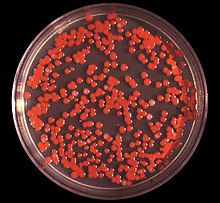Serratia marcescens
| Serratia marcescens | |
|---|---|
 |
|
| S. marcescens on an agar plate | |
| Scientific classification | |
| Domain: | Bacteria |
| Phylum: | Proteobacteria |
| Class: | Gammaproteobacteria |
| Order: | Enterobacteriales |
| Family: | Enterobacteriaceae |
| Genus: | Serratia |
| Species: | S. marcescens |
| Binomial name | |
|
Serratia marcescens Bizio 1823 |
|
Serratia marcescens (/sɛˈreɪʃjə mɑː(r)ˈsɛs.sɛnz/) is a species of rod-shaped gram-negative bacteria in the family Enterobacteriaceae. A human pathogen, S. marcescens is involved in hospital-acquired infections (HAIs), particularly catheter-associated bacteremia, urinary tract infections and wound infections, and is responsible for 1.4% of HAI cases in the United States. It is commonly found in the respiratory and urinary tracts of hospitalized adults and in the gastrointestinal system of children. Due to its abundant presence in the environment, and its preference for damp conditions, S. marcescens is commonly found growing in bathrooms (especially on tile grout, shower corners, toilet water line, and basin), where it manifests as a pink, pink-orange, or orange discoloration and slimy film feeding off phosphorus-containing materials or fatty substances such as soap and shampoo residue.
Once established, complete eradication of the organism is often difficult, but can be accomplished by application of a bleach-based disinfectant. Rinsing and drying surfaces after use can also prevent the establishment of the bacterium by removing its food source and making the environment less hospitable.
S. marcescens may also be found in environments such as dirt, supposedly "sterile" places, and the subgingival biofilm of teeth. Due to this, and because S. marcescens produces a reddish-orange tripyrrole pigment called prodigiosin, it may cause staining of the teeth. The biochemical pathway for the production of prodigiosin by S. marcescens is unknown except for the final two steps. In these steps, a monopyrrole and a bipyrrole undergo a condensation reaction by way of an enzyme to form prodigiosin.
...
Wikipedia
